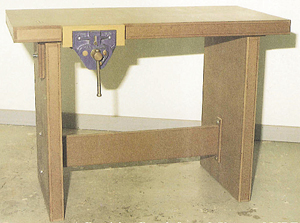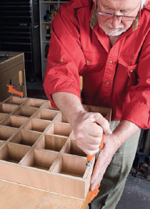
When making up the Torsion Box work surface [in the Inexpensive Workbench plan] or any other made-up workbench top, how do we handle twist or racking? I assume that most workbench makers are doing it because they do not have a workbench already. Even those that do, the finished product will be no better than the alignment method and base used. I have not seen this addressed in any workbench plans that I’ve seen. It would be a shame to spend our time and money and have a finished bench that is not the ideal flat surface we need and intended to have. – Lee Walkowski
Chris Marshall: It’s the age-old chicken-or-egg conundrum of which comes first – the flat workbench or the flat reference surface on which to build it. Well Lee, you raise a good point: in order to make a flat torsion box, you need a flat surface to assemble the gridwork of internal spars and then the outer “skins.” But, consider this. If you build the torsion box from quality, cabinet-grade plywood, or 1/2-in. MDF as those plans call for, and rip the spars and filler pieces on a good table saw, they’ll come off the saw with very flat edges to begin with. Assemble those on even a reasonably flat surface, then cover the grid with flat plywood or MDF and you’ll end up with a torsion box that’s pretty darn flat, I’ll bet. In terms of finding a flat work surface, here’s a suggestion: assemble it on your table saw table. If your saw’s top is pretty small, buy a sheet of 3/4-in. MDF, cut it in half or into thirds, widthwise, and lay two of those sheets on top. I’ve found it to be a good registration surface for assembling numerous projects before myself. Then put the torsion box together on this temporary MDF “bench.” When you’re done, use the MDF for other shop purposes (templates, jig and fixture parts, a router table top, etc.). MDF is reasonably cheap and handy to have around anyway.
One of our experts, Ian Kirby, wrote an excellent primer on torsion box construction in our June 2007 print issue.
Tim Inman:Research to learn how to use winding sticks to help solve your problem. The flatter the working surface you can make your benchtop on, the better. If the bench is really big, then maybe the concrete floor is the flattest “reference” surface you can use. If the benchtop is to be smaller than 4 X 8, then I would suggest setting up a plywood sheet for a work surface/reference top. Set the plywood on sawhorses. Use winding sticks and string diagonals to get a top that is free from twist and winding. Two pieces of string fastened to opposite diagonal corners will tell you when the top is free of warp or twist. Your eye and the winding sticks will tell you when the top is free of twist, too. When the plywood is right, build your torsion box on it with appropriate glue and screws. You’ll end up with a rigid flat torsion box that will be a joy to use.






